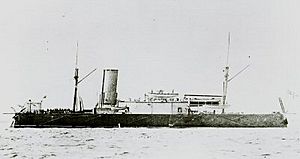HMS Belleisle (1876) facts for kids
 |
|
Quick facts for kids History |
|
|---|---|
| Name | HMS Belleisle |
| Builder | Samuda Brothers, Cubitt Town, London |
| Laid down | 1874 |
| Launched | 12 February 1876 |
| Completed | 19 July 1878 |
| Fate | Broken up 1904 |
| General characteristics | |
| Class and type | Belleisle-class ironclad |
| Displacement | 4,870 tons |
| Length | 245 ft (75 m) p/p |
| Beam | 52 ft (16 m) |
| Draught | 21 ft (6.4 m) |
| Propulsion |
|
| Sail plan | Square rig on foremast, gaff on mizzen |
| Speed | 12.1 kn (22.4 km/h) |
| Complement | 249 |
| Armament |
|
| Armour |
|
HMS Belleisle was a special kind of warship called an ironclad. She was one of four ships bought by the British government in 1878. This happened during a time when there was a fear of war with Russia.
Belleisle was one of two ships in her class, the other being HMS Orion. She was built in London by Samuda Brothers. She was originally meant for the Ottoman Navy and was named Peik-i-Sheref. The British Royal Navy bought her when she was almost finished. However, she needed many expensive changes to be ready for British naval service.
Contents
Ship Design and Features
Belleisle was first planned to have 10-inch guns. But one of the first changes was to make the gun openings bigger. This allowed her to carry much larger 12-inch guns. Other big changes included adding more space for coal. They also built extra cabins for officers. Special equipment for launching torpedoes was also installed.
Main Guns and Firing Angles
The ship's main guns were placed in a central, eight-sided area called a box battery. There were two guns on each side of this area. The way the gun openings were designed meant that two guns could fire straight ahead. They could also fire straight backward. And they could fire at a limited angle to either side of the ship.
There were small areas where only one gun could be used. But this was not seen as a big problem by the ship's designer. This was because the ship's main weapon was actually its ram. A ram was a strong, pointed part of the ship's bow. It was designed to smash into enemy ships.
Comparing Belleisle to Other Warships
Belleisle and her sister ship, HMS Orion, were smaller than other British battleships of their time. This meant they could not travel as far. They also were not as fast and did not carry as many weapons.
However, when they were first bought, naval experts liked them. They were much cheaper than other battleships. For example, they cost half as much as an Audacious-class battleship. They also cost only a third of the price of HMS Inflexible. But once people realized their weaknesses, they were not seen as good front-line fighting ships.
Service Life of HMS Belleisle
HMS Belleisle began its service on July 2, 1878. For the next 14 years, she served as a coastguard ship. Her home port was Kingstown, Ireland.
Daily Life and Incidents
Her main activities included firing practice four times a year. She also took part in the annual squadron cruise. She had one major repair and upgrade at Devonport. On July 18, 1886, the ship accidentally ran aground. This happened on the Pwllerochan Flat in Milford Haven harbour. Luckily, she was refloated later that same day.
Becoming a Target Ship
In April 1893, Belleisle was moved to the "B" Reserve fleet. This meant she was no longer actively serving. She then moved to the Fleet Reserve in May 1894. In May 1900, she was officially taken out of service. She was then changed into a target ship. This meant she would be used for testing new weapons.
She survived being shot at by HMS Majestic. During this test, shells filled with a powerful explosive called lyddite were used. After these tests, she was towed back to Portsmouth. There, she was used to test the effects of 6-inch and 9.2-inch guns. She was also used for torpedo experiments.
The torpedo tests were supposed to show how a material called cellulose could protect ships. It was thought that the cellulose would swell up and plug any holes made by torpedoes. But this did not happen. Belleisle sank into the mud. It was very difficult to raise her again. She was finally lifted in October 1903. Soon after, she was sold for scrap metal to Germany.

